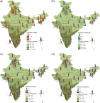Risk of dental caries and periodontal disease among older adults and elderly persons with diabetes in India: a population-based cross-sectional study
- PMID: 40383764
- PMCID: PMC12087086
- DOI: 10.1186/s12903-025-06067-2
Risk of dental caries and periodontal disease among older adults and elderly persons with diabetes in India: a population-based cross-sectional study
Abstract
Background: Oral health is a key indicator of overall well-being, and diabetes, a complex metabolic disorder, often leads to related oral health problems. Given the high prevalence of diabetes among Indian older adults and elderly persons, this study examines the diabetes associated risk of dental caries and periodontal disease among them.
Methods: This cross-sectional study analysed data from 65,562 adults aged 45 and above, based on the 2017-18 Longitudinal Ageing Study in India (LASI) Wave-1 survey. We used bivariate cross-tabulation to estimate the prevalence, chi-square analysis to examine the prevalence differentials and multivariate logistic regression to estimate the adjusted odds ratio (AOR).
Results: Bivariate analysis shows that diabetic older adults demonstrate a slightly higher prevalence of dental caries (20.43%) compared to those without diabetes (18.62%), but there is no significant difference in periodontal disease between the two groups. The regression analysis confirms that diabetes significantly increases the risk of both dental caries (AOR: 1.18, p < 0.001) and periodontal disease (AOR: 1.10, p = 0.008). Additionally, females and urban residents are at a higher risk of dental caries, while rural residents face a greater risk of periodontal disease. Socioeconomic factors, such as lower education and higher wealth, play a key role in caries and periodontal problems.
Conclusion: Effective management of diabetes-associated oral health problems in India requires a comprehensive, population-specific approach due to the country's diverse demographic and socioeconomic landscape. Tailored interventions focusing on diabetes care, education, and access to oral health services are essential, particularly for high-risk groups like older adults, women, rural residents, and those with lower education or socioeconomic status.
Keywords: Dental caries; Diabetes; Elderly population; Older adults; Oral health; Periodontal disease.
© 2025. The Author(s).
Conflict of interest statement
Declarations. Ethics approval and consent to participate: The analysis relies on secondary data which is available in the public domain for research purposes, so no approval from an institutional review board (IRB) was necessary. Thus, no ethical approval was required further to conduct the study. The Longitudinal Ageing Study in India (LASI) is a survey of individuals aged 45 and older and their spouses irrespective of their age. The survey was conducted by International Institute for Population Sciences (IIPS), Mumbai; the Harvard T. H. Chan School of Public Health (HSPH), Boston; and the University of Southern California (USC), Los Angeles. To conduct the survey, the aforementioned institutes obtained the ethical approvals from the following collaborating organizations: Indian Council of Medical Research (ICMR), Delhi; IRB, International Institute for Population Sciences (IIPS), Mumbai; IRB, Harvard T.H. Chan School of Public Health (HSPH), Boston; IRB, University of Southern California (USC), Los Angeles; IRB, ICMR National AIDS Research Institute (NARI), Pune; and IRB, Regional Geriatric Centres (RGCs), MoHFW. The survey agencies conducted the fieldwork after obtaining prior consent from the respondents. As part of the implementing the survey, survey participants were informed of the survey’s purpose, measures to protect their privacy, and the safety of health assessments as part of the informed consent process. In line with human subject protection protocols, four consent forms were utilized in LASI: household informed consent, individual informed consent, consent for dried blood sample collection for storage and future use, and consent for proxy interviews. Additionally, following recommended ethical guidelines, participants were provided with a copy of the consent forms, a biomarker results report card, and referral letters to public health facilities if any health measurements were found to be outside the normal range. Consent for publication: Not applicable. Competing interests: The authors declare no competing interests.
Figures










Similar articles
-
Prevalence of dental caries and periodontal diseases, and their association with socio-demographic risk factors among older persons in Delhi, India: a community-based study.Southeast Asian J Trop Med Public Health. 2013 May;44(3):523-33. Southeast Asian J Trop Med Public Health. 2013. PMID: 24050085
-
Dental caries and periodontal diseases among urban, rural and tribal school children.Indian Pediatr. 1993 Jun;30(6):759-64. Indian Pediatr. 1993. PMID: 8132255
-
Tooth morbidity and its impact on oral related quality of life in elderly tribal population-The Irula experience.BMC Oral Health. 2025 Feb 18;25(1):252. doi: 10.1186/s12903-025-05628-9. BMC Oral Health. 2025. PMID: 39966845 Free PMC article.
-
Caries and periodontal disease in Indigenous adults in Australia: a case of limited and non-contemporary data.Aust Health Rev. 2017 Aug;41(4):469-478. doi: 10.1071/AH15229. Aust Health Rev. 2017. PMID: 27567638 Review.
-
Impact of oral diseases on systemic health in the elderly: diabetes mellitus and aspiration pneumonia.J Public Health Dent. 2000 Fall;60(4):313-20. doi: 10.1111/j.1752-7325.2000.tb03341.x. J Public Health Dent. 2000. PMID: 11243053 Review.
References
-
- Saeedi P, Petersohn I, Salpea P, Malanda B, Karuranga S, Unwin N, Colagiuri S, Guariguata L, Motala AA, Ogurtsova K, et al. Global and regional diabetes prevalence estimates for 2019 and projections for 2030 and 2045: results from the International Diabetes Federation Diabetes Atlas. Diabetes Res Clin Pract. 2019;157:107843. - PubMed
MeSH terms
LinkOut - more resources
Full Text Sources
Medical

